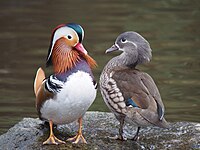
Photo from wikipedia
Callosobruchus seed beetles (Coleoptera: Chrysomelidae: Bruchinae) are pests of stored legumes in tropical and subtropical regions. The cuticular surfaces of female Callosobruchus seed beetles contain a contact sex pheromone, which… Click to show full abstract
Callosobruchus seed beetles (Coleoptera: Chrysomelidae: Bruchinae) are pests of stored legumes in tropical and subtropical regions. The cuticular surfaces of female Callosobruchus seed beetles contain a contact sex pheromone, which elicits copulatory behavior in congeneric males. Asymmetric cross-copulatory behavior was observed between C. maculatus and C. rhodesianus despite considerable differences in the structures of their contact sex pheromones. C. maculatus uses dicarboxylic acid, whereas C. rhodesianus uses two ketone compounds in conjunction with similar synergistic cuticular hydrocarbon blends in both cases. Male C. maculatus exhibited copulatory behavior with females of both C. maculatus and C. rhodesianus, but male C. rhodesianus mated only with congeneric females. To establish the reasons for the asymmetric cross-copulatory behavior of C. maculatus, we tried to identify the heterospecific mate-eliciting compounds in the cuticles collected from virgin C. rhodesianus females. The compounds were fractionated using acid-base partitioning and chromatography techniques and then assayed for their ability to elicit male copulatory activity. Gas chromatography–mass spectrometry (GC–MS) analysis of the active acidic fraction revealed the presence of three dicarboxylic acids: 2-methylsuberic acid (2-methyloctanedioic acid) (1), 3-methylsuberic acid (3-methyloctanedioic acid) (2), and nonanedioic acid (3). The synergistic effect was compared using synthetic standards and natural hydrocarbons. When the compounds were combined with the natural hydrocarbons, compounds 1 and 2 elicited significant copulatory activity in male C. maculatus. In contrast, relative to the effect of natural hydrocarbons alone, compound 3 did not exhibit significant copulatory activity when combined with natural hydrocarbons. The results demonstrated that the asymmetric cross-copulatory behavior of C. maculatus is induced by the presence of contact sex pheromone analogs on the cuticular surface of female C. rhodesianus. In combination with previous reports, although a saltational evolution was hypothesized for the contact sex pheromones of C. rhodesianus, this species continues to produce dicarboxylic acids functioning as pheromones that are structurally similar to those secreted by closely related species.
Journal Title: Chemoecology
Year Published: 2017
Link to full text (if available)
Share on Social Media: Sign Up to like & get
recommendations!